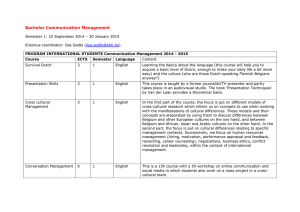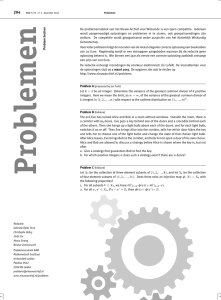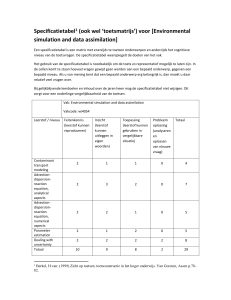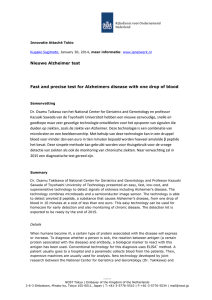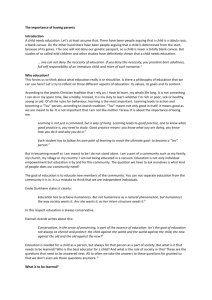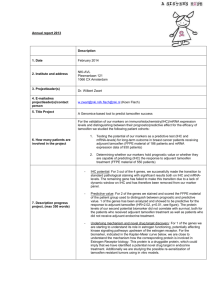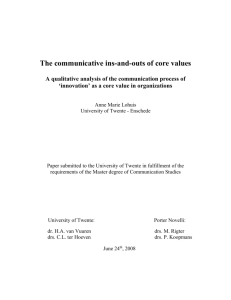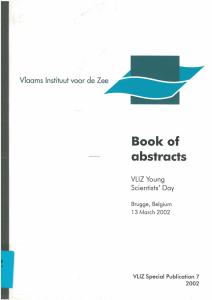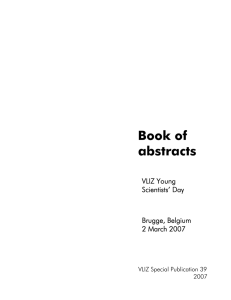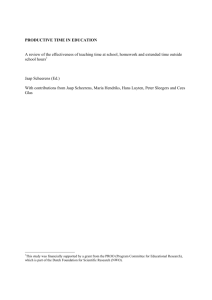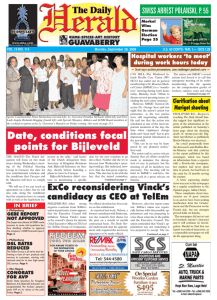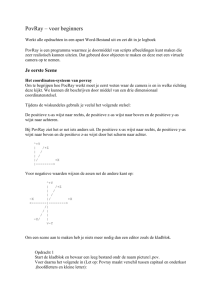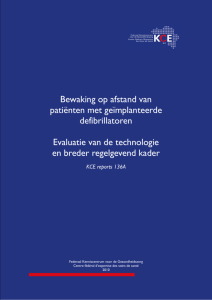- Syneratio
advertisement
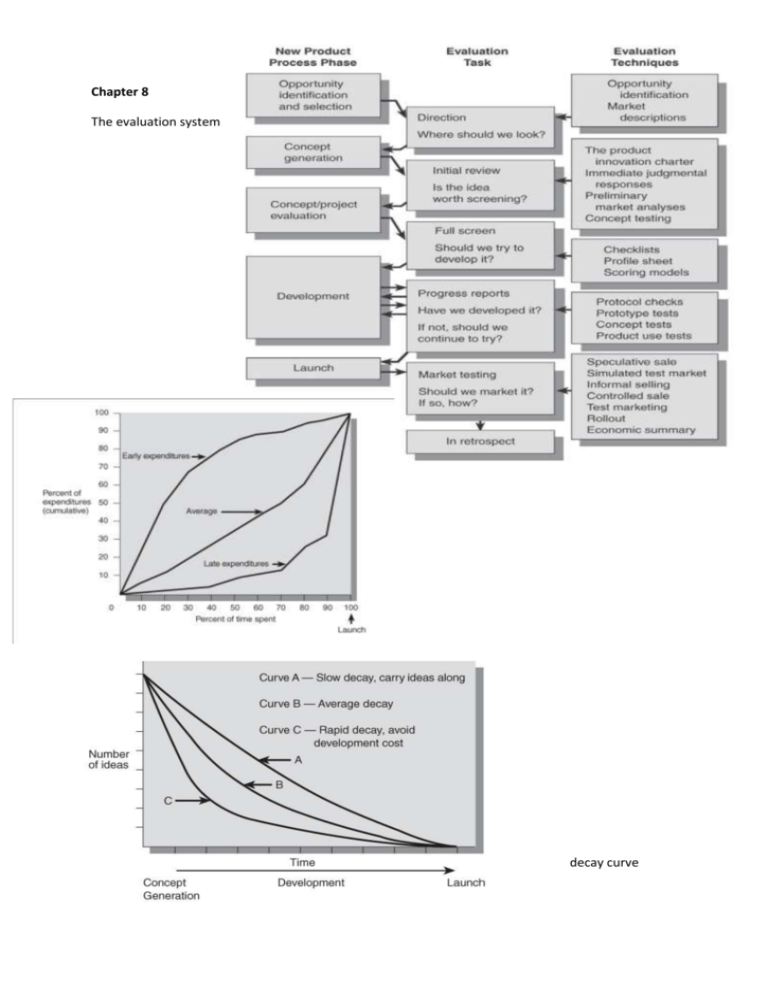
Chapter 8 The evaluation system decay curve risk/payoff matrix In general the new products team should consider 4 generic risk strategies avoidance eliminate the risky product project altogether mitigation reduce the risk to an acceptable and threshold level (drempel niveau) transfer move the responsibility to another organization in the form of a joint venture or subcontractor Acceptance: Develop a contingency plan now (active acceptance) or deal with the risks as they come up (passive acceptance). What results in some cases is a sort of rolling evaluation. The project is being assessed continuously, figures are penciled in, premature closure is avoided, and participants avoid mindsets of good and bad. This is, in a way, dealing with risk via acceptance or mitigation. We know product development projects are risky, so we evaluate, move to the next phase if warranted, and continuously upgrade the quality of information available to us throughout the process to minimize the chances of failure (mitigation) and o expect contingencies and deal with them as they come up (acceptance). Planning the evaluation system Profits everything is tentative (voorlopig) potholes of product innovation (kuilen van innovatie) kosten alleen veel geld als je ze niet ziet aankomen je werkt samen met mensen en mensen zorgen voor problemen (Surrogate) vergelijkbare producten om reacties te bekijken en voorspellen o Real Question Surrogate Question o Will they prefer it? Did they keep the prototype product we gave them after the concept test? o Will cost be competitive? Does it match our manufacturing skills? o Will competition leap in? What did they do last time? o Will it sell? Did it do well in field testing? A-T-A-R(awareness trial availability repeat) model wordt gebruikt om toekomstige inkomsten en verkopen te voorspellen. Profits from new product sales = Number of possible buying units (estimated target market size) X % of target customers that are aware of it X % of aware target customers who will try it X % of availability at retailers X measure of repeat: 1 + (% of repeated purchase X number of additional units bought) X profit per unit = revenue per unit - costs per unit Example alarm: Profits from new product sales = Number of possible buying units (estimated target market size NL): 1 200 000 X % of target customers that are aware of it: 40% X % of aware target customers who will try it: 10% X % of availability at retailers: 60% X measure of repeat: 1 + (% of repeated purchase: 15% X number of additional units bought: 1) X profit per unit = revenue per unit: Euro 34 - costs per unit: Euro 26 Units sold = 1 200 000 x 0.40 x 0.10 x 0.60 x 1.15 = 33 120 Profits from new product sales = 1 200 000 x 0.40 x 0.10 x 0.60 x 1.15 x (Euro 34 –26) = Euro 264 960 Diffusion of innovation for a person or a firm to become a regular buyer/user of an innovation there first must be awareness that it exists then there must be a decision to try that innovation, then the person must find the item available to them and finally there must be the type of happiness with it that lead to adoption or repeat usage Definitions ATAR Model Buying unit Awareness Available (% of stores) Trial (share results of something u tried with others which could not trial) Repeat First Evaluation of Individual Ideas Company / product strategy fit? Technology fit? Knowledge available? Portfolio fit? Market, cost, timing, … fit? Procedure More than one person (avoid bazooka effect) Idea source not included Keep records, stay objective The People Dimension in Scoring Scorers: May be always optimistic/pessimistic May be "moody" (alternately optimistic and pessimistic) May always score neutral May be less reliable or accurate May be easily swayed by the group May be erratic Chapter 9 Initial reaction special technique made by firms which handles deluge(overvloed van reacties en data) more systematically Get reaction to concepts by potential customers to: 1. Eliminate poor concepts 2. Estimate sales or trial rate 3. Improve concepts Bazooka effect snel afschieten van ideeën en suggesties One suggested way for firms to do a rough early screen is to evaluate it on three factors Market worth Firm worth Competitive insulation can the products advantage be maintained Careful when concept testing when: The prime benefit is a personal sense (aroma, taste) The concept involves new art and entertainment The concept embodies a new technology Customers do not know their needs The product concept is a claim of proposed satisfactions, this promise is open to 4 interpretations: producers perception of features consumers perception of features producers estimate of the benefits delivered by that set of features consumers estimate of the benefits delivered by that set of features Thus a complete new product concept is a statement about anticipated product features top-two-boxes score (the beste 2 resultaten mogelijk op een schaal van 5, dus zal het sowieso kopen en zal het waarschijnlijk kopen) Concept statement: Format: Narrative(verbal), drawing, prototype, virtual reality? Costs State of the concept What you want to test (e.g. functioning) Wording, colors, material, … Including price, competitive information, advertising? Commercialized concept statement A special variation regardless of format, concerns whether to make the statement as a commercialized concept statement, which is to present it in promotional style. e.q. light peanut butter a low calorie version of natural peanut butter that can provide a tasty addition to most diets. commercialized formats produce more realistic evaluations. Offering of competitive information Provide data sheet about each competitive product Price Reponse group situation and format Respondent group: All stakeholders (B-2-B customers, retailers, end-users, …)? Lead users, large users? Innovators and early adopters? Response situation & format: Personal contact? Individual vs. group? Big or small sample (400 vs. 20)? Benefit segmentation a firm may identify unsatisfied market segments and concentrate its efforts on developing concepts ideally suited to the needs of these segments Cluster analysis puts observations together into relatively homogenous groups on an importance map After the cluster analysis you can put the benefit segments onto the perceptual map which will result in a Joint Space Map. In deze map staan de mogelijke kans segmenten. Preference regression methods used to identify the optimum combination of attributes desired by the market Importance map Chapter 10 The full screen often involves the use of a scoring model which is an arrangement of checklists factors with weights on them. profile sheet scoring model veel = 5 punten weinig = 1 // meerdere vragen en meeste punten word de keuze culling factors stel je hebt minimaal 30 euro nodig voor een activiteit maar je hebt maar 30 euro dan moet je die activiteit gelijk wegstrepen van je mogelijke activiteitenlijst. dit in plaats van later er te doen If an organization automatically vetoes a proposed product if it scores poorly on a few "critical" factors, these critical factors identified by the firm are known as culling factors. sensivity testing Sensitivity (also called the true positive rate, or the recall rate in some fields) measures the proportion of actual positives which are correctly identified as such (e.g. the percentage of sick people who are correctly identified as having the condition). Analytical Hierarchy process product project screening and evaluation process AHP is een beslissingsmethode waarbij op basis van ogenschijnlijk abstracte beslissingscriteria via een voorgeschreven rekenmethode een concrete keuze kan worden gemaakt. AHP is een afkorting afgeleid van de (Amerikaanse) uitdrukking: Analytic Hierarchy Process. Uitgangspunt van de methode is een (vaak moeilijk concreet te maken) keuzevraag waar wel voorwaarden aan kunnen worden gesteld. De methode is zowel een psychologische als een wiskundige methode. De methode wordt voornamelijk gebruikt om in het keuzeproces de criteria die van belang zijn voor het maken van de juiste keuze van een waarde (een gewicht) te voorzien, waarna de mogelijke oplossingen wiskundig kunnen worden uitgerekend en vastgesteld. Chapter 11 Forecasts Reliable? Based on estimates / surveys Biased internal attitudes Poor execution of market research / accounting Target users don’t know / don’t tell us Market dynamics / competitive reactions? Impact of marketing? Basing forecasts on history Technology revolutions Don’t (fully) rely on sales forecasts Make best / worst case scenarios Based on averages when someone says he will buy the product definitely they will buy it 80% off the time and when they say they will buy it maybe it is 33%. Using the A-T-A-R Model for sales forecasting MS = T * R * AW * AV R = Rs / (1 + Rs – Rr ) MS = Long run market share T = ultimate long run trial rate (The % of all buyers who ultimately try the product at least once) R = Ultimate long run repeat purchase rate (Share of purchases of the product among those who tried the product) AW = % Awareness AV = % Availability Rs = proportion switch to new product when it comes available Rr = proportion of customers who repeat purchase the product Diffusion of innovation refers to the process by which an innovation is spread within the market, over time and over categories of adopters. Quantitative innovation diffusion models can also be used in predicting future product category sales based on historical product sales levels. E.Q. The Bass model s(t) = pm + [q – p] Y(t) – (q/m)[Y(t)]2 P = initial trail probability Q = Diffusion rate parameter M = total number of potential buyers Y(t) = Total numbers of purchases by time t Summary of the problems of forecasting: Target users don’t always know what the new product will actually be what it will do for them competitors don’t sit still Information about marketing support may be lacking rushing the product can get people in trouble New products don’t have a history so people can’t use the forecasting models Reduce dependency on poor forecasting Forecast what you know and not what you do not know approve situations, not numbers commit to a strategy of low cost development and marketing go ahead with sounds forecast but prepare to handle the risks use different methods of financial analysis on new products depending on the situation improve current forecasting models (ATAR) Hoechst US scoring model Chapter 12 Concurrent system Simultaan werken aan het process in plaats van wachten tot een stap afgerond is tot eraan de volgende stap begonnen wordt Product Protocol What is the final package of output from the development system Starting development means that many functions and people will work on many different tasks in parallel ‘Something that keeps the team together’ Agree on: o Product definition & requirements o Project planning & deliverables (what, when, how, by whom) May be difficult due to politics and internal competition Core benefit = augmented product concept Protocols specific content (Must’s and Want’s): Target market (specify market) Product positioning (sell the product in 1 sentence) Product attributes (benefits, functions, features) Competitive comparison (multiple / none) Augmentation dimensions (financing arrange able with us if necessary, generous warranty, complete installation service) Time planning (market is open for 2 years / will open in 1 year) Marketing Financial requirements (intro and development losses will not exceed) production requirements (once we announce there must be no interruption of supply) regulatory requirements (regulations are from many sources and vary by states and locations) corporate strategy requirements (diversification of markets, enhanced reputation for innovativeness) Potholes (massive potholes potential cause of its newness) It is important to keep eye for the customer needs and requirements. the Voice of the Customer is important in the product protocol. Quality Function Deployment invented in the Japanese Automobile industry as a tool of project control in an industry with incredibly complicated projects. It can lead to reduced design time and costs and more efficient communication between project team members from functional areas. The role of Protocol in the new products process: The first step of QFD has received the most attention and has been useful to the largest number of firms House of Quality The HOQ requires inputs from marketing and technical personnel and encourages communication and cooperation across these functional areas. In addition to a protocol to ensure that customer needs are also considered during: o Product engineering o Parts deployment o Process planning o Production planning Encourages and improves long-term cross-functional communication and interaction Costs money and time There are several benefits of applying QFD: Everything from product engineering to designing the production process is driven by customer needs To get the benefits out of the QFD the various function areas really have to work together QFD encourages cross functional dialogue and interaction throughout the technical development process. which is precisely the kind of agreement called for by the product protocol. Criteria for good team selection Make sure the team is cross functional appoint an administrator and an advocate for the voice of the customer team members should have ultimate responsibility to act on the results The efficiency of QFD can also be improved by doing one or more of the following: Concentrate on only some of the engineering characteristics Organize the engineering characteristics into groups and designate responsibility do a cost benefit analysis on each engineering characteristic All around the room are boards that guide discussion of the product project. The Oobeya room would include: An objective board (containing Toyota’s version of a PIC: background, objectives, technical specifi cations, and project organization) A metrics board (showing current project status and allowing for team members to determine where they are at, or behind, target) An action board (showing the activities of all members on the team that are required to reach the objective and indicating which activities are already completed) A decomposition board (indicating which sub-projects need the most attention) An issue board (showing the most critical problems that have arisen, used to stimulate discussion between team leader and team members and to assign accountability) Chapter 13 Contributions of Design to the New Products Process Design for speed to market Design for ease of manufacture Design for Differentiation Design to meet customer needs Design to build or support corporate identity Design for environment Ergonomie de studie van de mens in zijn omgeving Computer-Based Visuals & Prototypes Rapid prototyping Renderings Virtual reality Product Functioning: Interaction Design (talk with users/testing) User-oriented design ergonomics universal design o o o o o Equitable: for people with varied abilities Flexibility: fits a variety of preferences and abilities Intuitive: functioning simple and easy to understand Tolerance for error: no adverse consequences of misuse Low physical effort Process & cost improvements Speed to market Ease of manufacturing Ease of assembling Optimal packaging Lower costs of o Components o Storage o Shipping Design for Sustainability using green design and cradle-to-cradle design Communication design Packaging,Logo and Sound design (nivea, kookgerei, t-mobile) The importance of Product Architecture Impact on: Product performance and benefits Product features Product functioning Product form (aesthetics) Manufacturing Speed-to-market Platform possibilities Managing Design in Product Innovation Design is not only the responsibility of designers = cross-functional cooperation required Involve designers from the very beginning Involve users, suppliers, etc. Computer-Based Design CAD (computer-aided design) CAM (computer-aided manufacturing) CAE (computer-aided engineering) DFM (design for manufacturability) Product architecture has been described as the process by which a customer need is developed into a product design Create the Product Schematic. The schematic shows the components and functional elements of the product and how they are interconnected 1. Create the Product Schematic. The schematic shows the components and functional elements of the product and how they are interconnected. Several alternative schematics may be developed and explored at this point. For the CD player-recorder, one might develop a version designed to plug into a standard stereo system. 2. Cluster the Schematic Elements. Here, the chunks (or modules) are defined. In the figure, input, disk, output, and power chunks are identified. Interaction among the chunks should be simple so changes can be easily effected, and one should take advantage of manufacturing capabilities wherever possible. 3. Create Geometric Layout. Here, using simulations, computer-aided design, or other techniques, the product is arranged in several confi gurations to determine the “best” solutions. For example, should the disk load in the front or the side of the CD player? 4. Check Interactions between Chunks. Understand what happens at the interfaces between chunks. In the CD player, sound flows as a digital signal to the disk during recording, and also as a digital signal from the disk during playback. Several techniques are currently being used to make sure that design is integrated correctly with other functions during the development phase and that the products being designed can be manufactured in a cost-efficient way. Important among these is colocation (putting the various individuals or functional areas in close proximity. Colocation helps integrate departments and improve information flow, and also allows the team members to identify and resolve product development problems quicker. Simultaneous with development (on goods and services) is the development of the augmented aspects of the product—pre- and postsale service, warranty, image, and so on. This activity, most often led by marketing people, is called envelope design, Chapter 14 Matrix team Functional work is done by various departments with very little project focus Functional Matrix team of different departments but the project is still close to the current business Balanced Matrix both projects and functional views are critical Project Matrix need for stronger project push Venture extends projectization to its ultimate and is most useful for new to the world or new to the firm products Building a team Selecting the team members (core team, ad hoc members) Selecting the right leader (= general manager) Establishing a culture of collaboration Clarity of goals and objectives Roles and participants Network building o a network consist of nodes links and operation relationships Nodes people important to the project Links how they are reached and what important ties they have to others in the network Operation relationship how these people are contacted and motivated to cooperate Training in teams Managing Team Motivation Team assignment and ownership (empowerment, commitment, enthusiasm, and pride) Senior management involvement Compensation and rewarding o Monetary vs. non-monetary (GELD) o Process- vs. outcome-based Globally Dispersed Teams Virtual teams Electronically linked Synchronous / asynchronous Regular face-to face meetings Team conflicts more challenging Different language skills Cultural differences Less cross-functional integration Teams need the Integrators , who love to relate to people from other departments or other fi rms. They naturally give, and get, respect. Receptors respect others and welcome information from them but do not desire personal relationships. They are good contacts but not particularly good team members. Isolates prefer to be left alone. They are deep specialists in their fi eld and really want nothing to do with people from other functions The core team includes those people who are involved in managing functional clusters. Thus, one marketing person may represent, speak for, and guide 10 to 12 others in the sales and marketing areas. The core team members are active throughout and are supported by ad hoc team members. Ad hoc members are those from important departments (e.g., packaging, legal, logistics) whose importance is brief in time and thus not needed on the core team. Extended team members may come from another division of the firm, corporate staff, or another firm. Though extended team members can come from just about anywhere, firms are increasingly seeing the value of including key suppliers on the team Nodes are people important to the project in some way. Links are how they are reached and what important ties they have to others in the network. Operating relationships are how these people are contacted and motivated to cooperate in the proje Chapter 15 Our task is to devise a method for testing the end users’ experience with the new item, and we call the activity product use testing (PUT) , or field testing , or user testing . Use testing means testing the prototype under normal operating conditions Why? Assessing Competitive Reaction A firm developing new items is well advised to build its innovation on a technology base where it has some insulation from competitive copying. Second, competitors today are finding that copying someone else has small gains—others will copy them, price competition will take the profits away, the imitator usually copies the innovator’s mistakes too, and the competitors we must worry about most are themselves involved in technologybased developments that cannot be thrown over on short notice. The Complexity of Customer Needs In almost every industry, there is no one, simple, end-user need. Any new item foists onto the end user a learning curve. There are tradeoffs, and there is “baggage”— things that came with the new item that often surprise even the developer. End use is indeed complex, and there is no way it can be simulated in laboratories, where use is isolated from user mistakes, competitive trashing of the concept, and objections by those in the user fi rm or family whose work or life is disrupted by the change. In addition, for new-to-the-world products, several product use tests may be needed for a company to get it right—what is important is that the company learns from its errors. Customers’ Communication of Their Needs End users also often have trouble communicating their wants and their satisfactions, short of having the finished item. Two firms (Mars and Hershey) marketed food items with new synthetic fats (from NutraSweet and P&G, respectively). Both cases faltered on a surprise diffi culty: Just what do consumers really want in a dessert or a candy bar? Is sweetness an index of enjoyment? Does the term fat substitute destroy expectations of pleasant taste? And so on. One firm went national and the other into an expensive test market before these obstacles became clear. gamma testing moet alle problemen oplossen voor het uitbrengen van het product (product is klaar maar de manuals/verpakking nog niet) Beta-tests are short-term use tests, at selected external customer sites, sometimes preceded by internal alpha tests with employees. These are designed to tell the manufacturers one thing: Does this product work, free of bugs? In fact, some have their people competing to see who can find the most bugs in a new item—better now than later. 8Beta tests are not designed to tell them about meeting customer needs and solving problems—such testing takes longer than the few weeks usually allowed on computer products. • Beta test site firm has no internal capacity to test the performance of the product at the required level and lacks the funding to hire an outside fi rm to do the test. • Developer puts in a wishy-washy performance requirement like “user-friendly,” which is meaningless unless a measurable specifi cation is defi ned. • Testing is done too late in the new product process, which almost ensures that development time will be extended and production delays will occur. Doing testing in increments throughout the process is a way to avoid this pitfall. • Developers attempt to bypass beta testing, relying only on alpha testing of their own products. By defi nition they are too close to the product to critically test it and fi nd problems. • Developers ignore early negative results, hoping that the product will improve by itself during the new product process. All beta test results, whether positive or negative, need to be honestly evaluated. Gamma testing designates the ideal product use test, where the item is put through its paces and thoroughly evaluated by the end user. To pass this test, the new item must solve whatever problem the customer had, no matter how long it takes. Pre-Use Sense Reactions Almost every product gives the user a chance to react to immediate sensations of color, speed, durability, mechanical suitability, and so on. Apple and other software manufacturers may use case-based research as a very comprehensive form of product use testing that runs parallel to the software’s development process, from early concept to finished product. The first stage is investigation: The developer interviews users to learn their expectations and how they will likely use the product. In the development stage, users are encouraged to try early prototypes of the new software and explore its menus and features. As an interesting twist, they speak out loud during product use, describing any problems they encounter. This stage is followed by a preliminary beta test with end users in a real work environment. In a monadic test where the respondent tests a single product for a period of time. Services usually must be monadic, though there are exceptions. • In a sequential monadic test where there are back-to-back monadic tests with the same respondent. It is sometimes called a staggered paired comparison . In a paired comparison where use of the test product is interspersed with that of a competitive product. • In a triangular comparison, similar to paired comparison but with two competitive products versus one test product (or two test products versus one competitor). Gamma testing designates the ideal product use test, where the item is put through its paces and thoroughly evaluated by the end user. To pass this test, the new item must solve whatever problem the customer had, no matter how long it takes. Gamma testing is so critical on new medicines and medical equipment that the United States demands it; such testing can take up to 10 years.
